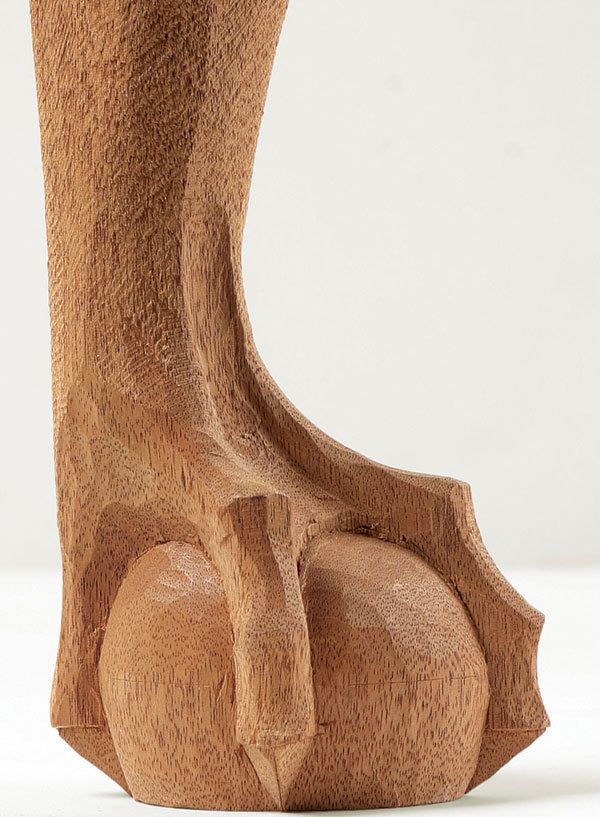Carve a ball-and-claw foot
Secrets shared to master this high-class element
The ball-and-claw foot is thought to have originated in China as a dragon’s claw grasping a pearl, but by the mid-18th century it had become firmly associated with the Chippendale furniture style. The design lends itself to interpretation and there are variations associated with different parts of the 13 colonies. While the claws and the talons may appear intimidating, carving them isn’t.
The secret is in the layout lines (download template and detailed photos). With these to guide you and by following the correct sequence of cuts, carving these feet is like carving by numbers. Nor do you need a cabinet full of carving gouges: Five or six will get you by, with a 1/2-in. bench chisel doing much of the work. After perhaps one practice foot on an easily carved wood such as basswood, you’ll be ready to slice into mahogany.
<!– –>
Bandsaw the blank and lay out the lines
After bandsawing the leg blank (in this case 2-3/4 in. sq. and at least 16 in. long), I begin by marking out the base of the foot (see photos, in above slideshow).
Many carvers use a chisel to define the edges of the talons, but I saw down the layout lines until I reach the outer circle. (I know this quicker method was used in the past, because I have found traces of sawtooth marks when examining antiques.) On the front talon and the front faces of the side talons, you can keep the saw perpendicular to the base of the foot; but on the remaining cuts, saw only the bottom half of the ball to avoid cutting into the ankle. In all cases, saw just outside the line to preserve the full width of the talon.
Now lay out the rest of the ball (see photos, in above slideshow). First draw lines on the bottom of the foot from the intersection of the talon lines and outer circle to the edge of the foot. Then, on all sides of the foot, mark the break point (the widest point of the ball), the height of the ball, and the center point of the ball. Next, extend the lines you drew on the bottom up to the break point, and then outline the top curve of the ball connecting the center point down to the break point. Now you can finally pick up a gouge and start carving.
<!– –>Carve the front and rear of the ball
The first step is to relieve the wood around the sides of the ball. Beginning with the back quadrants of the foot, make vertical cuts around the top half of the ball and then relieve the cuts by removing wood from the top side of the cuts. The cut needs to extend 516 in. deep; measure it with a depth gauge or improvise with a nail driven through a small piece of wood. Extend the channel down the bottom sides of the ball.
Before shaping the ball, establish a cylinder. Pare away wood until you get down to the outer line on the bottom of the foot. Use a square to check that the surface of this cylinder is flat.
Carving the front quadrants begins slightly differently. Where the line marking the top of the ball and the center line of each quadrant intersect, make a series of vertical cuts with a #7-18 mm gouge, working progressively toward the front. Next, with a 1/4-in. bench chisel, make small horizontal cuts to create a semicircular hollow. Then follow the same steps as the back quadrants and establish a flat cylinder.
Reestablish the break-point line at 7/8 in. from the bottom. With the 1/2-in. chisel, create the top curve of the ball (see photos, in above slideshow) and then pare down to the inner circle on the bottom of the foot to establish the lower curve of the ball.
Shape the talons, claws, and web
It doesn’t matter if you start shaping the talons before you finish carving the lower side of the ball. The first step is to use a #49 patternmaker’s rasp on the triangular bottom section of each talon; then create a concave profile between the second and third knuckles. Use the rasp to round the ankle of the leg and round over the shin area.
Round over the flat-topped knuckle and claw section using a 1/2-in. chisel. With a marking gauge set to 1/2 in., mark the junction of the first knuckle and the claw. With the chisel, refine the concave sections between the lower two knuckles on the front three talons. The rear talon has only the lowest knuckle.
To carve the claws, use the 1/2-in. chisel, and start by carving a flat slope from the first knuckle down to the inner circle on the bottom of the foot. Extend the line on the bottom of the foot up the center of the slope to mark the center of the claw. With the chisel parallel to the bottom of the foot, drive it into either side of the slope at the first knuckle until the corners of the chisel just touch the center line and the surface of the ball. You are undercutting the first knuckle. Then pare away the wood on either side of the center line to create the claw.
The final step is to create the concave area between the front tendon and the two side ones. Known as the web, it represents the stretchy skin found on the feet of birds of prey. Create the center of the groove, and then establish the top and the sides. Then flatten the center of the web with a #5-16 mm gouge, and if necessary, reestablish the line where the webbing meets the ball with the #7-18 mm gouge.
Your ball-and-claw foot is complete. Go back and smooth the ball with small rasps and files, and the ankle and talons with files and a scraper. Leave a few carving facets to show that this was created by man and not a machine.
From Fine Woodworking #186



















Log in or create an account to post a comment.
Sign up Log in